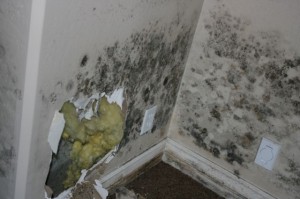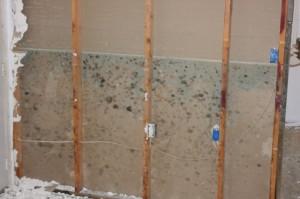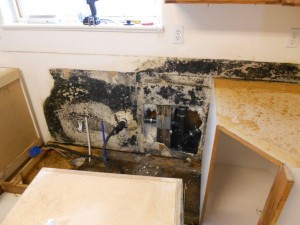Q: How do you clean up mold?
A: This is a common question when a homeowner is worried about mold growth in the home. Here is a basic rundown of what is done during a mold test and what a professional restoration company such as ARS Flood and Fire Cleanup does during mold remediation.
Mold Testing
Mold testing is the collection of mold samples for laboratory analysis. Usually it is an Industrial Hygienist that will come and take both surface and air samples to be tested in a laboratory although there are some do-it-yourself home mold tests on the market. A surface sample is taken directly from the surface by a tape lift imprint, a cotton swab, or actual piece of mold surface. For air samples, a canister called a spore trap will be set, and a representation of the mold in the air will be determined by the number of spores that are captured. The surface and air tests are important to identify what types of molds are present. This data is useful in determining proper remediation procedures as well as the seriousness of potential risks. The data from the test can be used in determining what needs to be done to remove any mold spores found.
Mold Remediation
Mold remediation is basically the process taken to clean up mold damage, usually done by a professionally certified restoration company such as ARS Flood and Fire Cleanup. Here are the steps we take to cleanup mold in a home or business:
The first step is to correct the moisture problem that is causing mold to grow. There are many causes of moisture in a home. Some of them are leaky pipes or drains, improper drying of surfaces after a flood, or condensation build-up. The bottom line is that all moisture problems need to be fixed to prevent further mold damage.
The second step is safety. Mold has the potential to cause serious health concerns, which is why during mold remediation it is imperative to protect the health and safety of the occupants and technicians. ARS technicians prevent exposure during cleanup by wearing safety equipment such as full face respirators, suits and gloves. They also prevent mold from spreading through the air by containing the mold spores with a negative air machine/air scrubber which draws air from the contaminated room and other rooms and releases it clean and filtered.
The third step is removal of the mold spores. ARS technicians are trained to safely remove mold from all types of surfaces or locations. If mold is located in the drywall or behind the wall, technicians remove the contaminated area, plus an efficient amount surrounding it to ensure all mold spores are removed. They then use a Hepa Vacuum to vacuum and contain the mold spores to keep them from being released into the air. If located on lumber or framing of the home, the technicians sand the lumber or material, Hepa Vacuum the spores and then spray anti-microbial to promote killing any other mold spores.
The fourth step is reconstruction of the area to repair it to its pre-mold condition. This may include replacing drywall, carpet or any other surfaces affected by mold growth. Whatever needs to be done to return the home or building office back to the pre-loss condition can be done through ARS.
In conclusion, when a homeowner can see mold growing or is aware of a mold problem already, they do not need to get a mold test but can call a restoration company to begin the mold remediation process. Call ARS Flood and Fire Cleanup and we can set up an appointment for an estimator to visit your home and determine what it will take to cleanup any mold. If you cannot see mold spores but are worried about mold growth behind walls etc. we can schedule an appointment for you with an industrial hygienist to test your home for mold.





